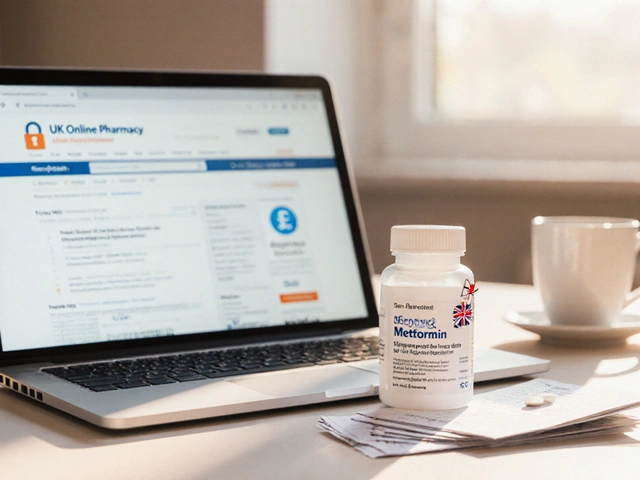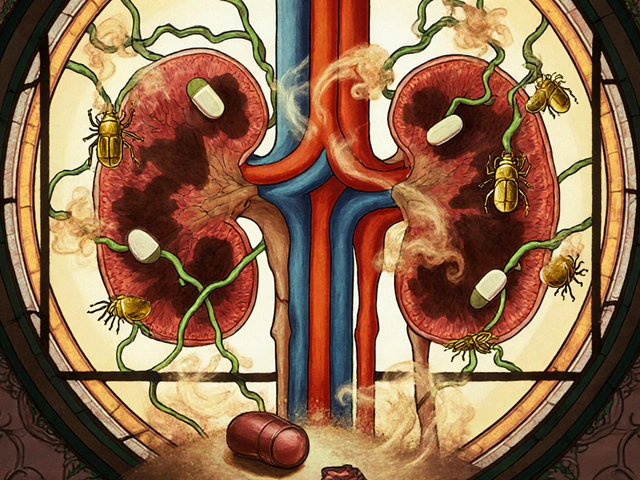PMS Symptom Tracker
Log Symptoms
Symptom Summary
Current Cycle Report
Average Severity: 0
Symptom Duration: 0 days
Most Frequent Symptom: None
Dealing with Premenstrual Syndrome (PMS) is a set of physical and emotional symptoms that appear in the luteal phase of the menstrual cycle can feel like a solo battle, especially when the pain or mood swings spill over into work, school, or relationships. The good news is you can change the script by learning how to advocate for PMS effectively. Below is a step‑by‑step guide that turns knowledge into confidence, so you can get the support you need without the drama.
Why Self‑Advocacy Matters
Self‑advocacy isn’t just about demanding accommodations; it’s about communicating clearly, backed by data, and building partnerships with the people who can help. When you frame your experience as a health issue rather than a personal quirk, doctors, employers, and family members are more likely to respond with concrete solutions.
Know Your Body: The Hormonal Basics
Understanding the hormonal rollercoaster demystifies many PMS symptoms. After ovulation, estrogen peaks, then drops while progesterone rises. The sudden shift can trigger bloating, breast tenderness, fatigue, and mood changes. That’s why symptoms cluster 5‑14 days before the period starts.
Gather Evidence: Tracking Your Cycle
Data is your strongest ally. Use a menstrual‑cycle app, a simple spreadsheet, or a paper journal to record:
- Start and end dates of each cycle
- Specific symptoms (headache, irritability, cramps, etc.)
- Severity on a 1‑10 scale
- Diet, sleep, exercise, and stress levels
After a few months you’ll spot patterns, and you’ll have concrete proof to show your gynecologist or workplace HR representative.
Medical Options: From Lifestyle to Prescription
When you sit down with a doctor, come prepared with your symptom log. Common treatment avenues include:
- Hormonal therapy - birth control pills, continuous‑cycle regimens, or progesterone‑only pills can smooth hormonal fluctuations.
- Dietary supplements such as calcium, magnesium, vitamin B6, and vitamin D - research shows modest reductions in mood swings and cramping.
- Cognitive Behavioral Therapy (CBT) targets negative thought loops that can amplify PMS emotional symptoms - a 12‑week program often costs less than medication and has lasting benefits.
- Non‑steroidal anti‑inflammatory drugs (NSAIDs) for pain relief, taken at the first sign of cramps.
Ask your provider about side‑effects, interactions with existing meds, and whether a trial period makes sense for you.
Workplace Advocacy: Getting Reasonable Adjustments
Many countries, including the UK, consider severe PMS a disability when it substantially limits major life activities. That means employers must consider reasonable adjustments under the Equality Act 2010. Here’s how to start the conversation:
- Choose the right moment - schedule a private meeting, not a hallway chat.
- Present your data - bring a one‑page summary of your symptom log, highlighting days when performance dips.
- Suggest specific adjustments such as flexible start times, a quiet work space, permission to take short breaks, or the ability to work from home on high‑symptom days.
- Know your rights - reference the Equality Act and your company’s inclusion policy.
Most managers appreciate a solution‑focused approach. If they push back, ask for a written response and involve HR.

Family and Friends: Building a Support Network
Sometimes the toughest battles happen at home. Explain what PMS feels like in plain language - "I’m not being moody for fun; my hormones are literally shifting my brain chemistry." Share your tracking sheet so loved ones can see the pattern. Ask for concrete help, like a grocery‑run on heavy‑cramp days or an ear to listen when anxiety spikes.
Lifestyle Hacks that Reinforce Your Advocacy
While medical and workplace strategies are crucial, daily habits can lessen symptom severity, making your advocacy easier because you’re feeling better.
- Exercise regularly - 30 minutes of moderate cardio or yoga three times a week lowers cortisol and eases cramps.
- Eat balanced meals - prioritize complex carbs, lean protein, and plenty of leafy greens; limit caffeine, sugar, and salty snacks that worsen bloating.
- Prioritize sleep - aim for 7‑9 hours; a consistent bedtime routine reduces irritability.
- Practice stress‑relief techniques - deep‑breathing, progressive muscle relaxation, or short mindfulness sessions can cut mood swings by up to 40% (study from University of Manchester, 2023).
Checklist: Your Self‑Advocacy Toolbox
| Task | When to Do It | What You Need |
|---|---|---|
| Track symptoms daily | Every day of cycle | App or journal, severity scale |
| Review patterns | End of each cycle | Spreadsheet summary |
| Schedule doctor appointment | Before symptoms worsen | Symptom log, list of questions |
| Prepare workplace request | After 2‑3 cycles of data | One‑page brief, suggested adjustments |
| Practice a stress‑relief technique | Daily, especially during luteal phase | Guided audio, yoga mat |
Common Pitfalls and How to Avoid Them
Skipping documentation. Without a record, you’re relying on memory, which can be dismissed as “just a bad day.” Keep the log.
Being vague with requests. “I need help” is too broad. Specify the adjustment, the reason, and the expected outcome.
Assuming everyone knows what PMS is. A brief fact‑check, like “PMS affects up to 85 % of menstruating adults,” can set the stage.
Relying on one strategy. Combine medical, workplace, and lifestyle approaches for the best results.
Resources and Communities
Connecting with others can boost confidence and provide fresh ideas. Consider these options:
- PMSUK - UK‑based charity with guides and a helpline.
- Reddit’s r/PMS - community of people sharing personal coping tactics.
- National Health Service (NHS) “Menstrual health” page - up‑to‑date medical advice.
- Local women’s support groups - often listed on council community boards.
Putting It All Together: A Sample Dialogue
Below is a realistic script you can adapt when talking to your manager:
You: “Thanks for meeting with me. Over the past three months I’ve noticed a pattern of severe PMS that peaks about a week before my period. I’ve logged my symptoms, and they show a consistent dip in focus and energy on those days.
You (continue): I’d like to propose a temporary flexible start time, allowing me to begin at 10 am on high‑symptom days. This adjustment would let me work from home if needed and ensure my productivity stays high.”
Manager: “I wasn’t aware PMS could impact work that much. Let me review your log and see how we can accommodate you.”
Notice how the conversation stays factual, solution‑oriented, and backed by evidence.
Quick Takeaways
- Track symptoms every day; patterns empower you.
- Bring data to medical and workplace discussions.
- Know your legal rights under the Equality Act.
- Combine medical treatment, lifestyle tweaks, and clear communication.
- Lean on support groups for moral and practical help.
Frequently Asked Questions
Can I get workplace adjustments for PMS without a formal diagnosis?
Yes. While a formal diagnosis can strengthen your case, the Equality Act protects anyone whose condition substantially limits daily activities. Providing a clear symptom log and suggested adjustments is usually sufficient.
What over‑the‑counter options actually help with PMS?
NSAIDs for pain, magnesium (300‑400 mg daily), calcium (1,200 mg), vitamin B6 (50 mg) and vitamin D (1,000 IU) have the strongest evidence. Always check with a doctor before combining supplements.
How long does CBT usually take to show results for PMS?
A typical program runs 8‑12 weekly sessions. Many participants notice mood improvements after the first 4‑6 weeks, with lasting benefits beyond the therapy period.
Is it okay to take a day off work for severe PMS?
If symptoms are severe enough to affect your ability to perform essential duties, a short sick leave is appropriate. Document the day’s impact and discuss longer‑term adjustments with HR.
Can lifestyle changes replace medication for PMS?
For mild to moderate cases, exercise, diet, sleep hygiene, and stress‑relief techniques can be enough. Severe cases often benefit from a combined approach of lifestyle and medical treatment.







Avril Harrison
October 18, 2025 AT 20:54Honestly, I think the guide hits the sweet spot between science and day‑to‑day practicality. It’s nice to see a piece that respects the cultural nuances of how women experience PMS across the UK. The checklist is a solid starter for anyone feeling overwhelmed. Keep sharing this kind of balanced advice!
Sarah Hanson
October 24, 2025 AT 15:48Thank you for the thorough overview; the data‑driven approach is commendable. I would recommend adding a brief section on insurance coverage, as many patients seek clarity on that front. Please consider this suggestion for future revisions. (definately)
Nhasala Joshi
October 30, 2025 AT 09:41Wow, this post is practically a manifesto for #PMS empowerment! The way you detail hormonal flux is spot‑on, yet the pharma industry is still pushing “miracle pills” that are nothing but placebo 🎭. Remember, the secret lies in decoding the bio‑signal matrix and taking control of the narrative. 🧬✨
Karla Johnson
November 5, 2025 AT 04:34I’ve been following the self‑advocacy framework for months, and let me walk you through the cascade of effects it triggers. First, the act of logging symptoms forces you into a reflective mode that uncovers hidden patterns you might otherwise ignore. Second, those patterns become quantifiable evidence you can present to clinicians, which dramatically shifts the power balance in the consultation room. Third, when you translate that data into a succinct brief for your employer, you remove the guesswork that often fuels bias. Fourth, the simple act of naming your needs-whether it’s a flexible start time or a quiet workspace-creates a concrete request rather than a vague plea. Fifth, the employer’s response, even if tentative, provides a feedback loop that you can iterate on. Sixth, the psychological relief of being heard reduces stress hormones, which in turn mitigates some of the physical symptoms you were tracking. Seventh, regular exercise and dietary adjustments amplify this positive feedback, creating a virtuous cycle of wellbeing. Eighth, the community support you gain from forums like r/PMS adds a layer of social validation that counters isolation. Ninth, the legal knowledge of the Equality Act equips you with a safety net should any discrimination arise. Tenth, the empowerment you feel ripples into other areas of life, from personal relationships to financial decisions. Eleventh, the confidence you build can inspire others in your circle to adopt similar practices, multiplying the impact. Twelfth, each successful accommodation reinforces the narrative that PMS is a legitimate health concern, not a whimsical inconvenience. Thirteenth, the cumulative effect of these steps is a measurable boost in productivity and morale. Fourteenth, the data you collect over successive cycles serves as a personal health archive that can guide future medical interventions. Fifteenth, the habit of self‑advocacy transforms you into a proactive health manager rather than a passive recipient. Finally, the journey itself, with all its challenges and victories, reinforces the truth that knowledge truly is power.
Linda A
November 10, 2025 AT 23:28In contemplating the interplay of body and bureaucracy, one discerns that true agency arises when data meets dignity.
Joe Moore
November 16, 2025 AT 18:21Yo, Nhasala, I totally get the vibe-big pharma *definately* ain’t looking out for us, they’re more about profit than health. The system’s rigged, but tracking our cycles is the rebel’s toolkit. Let’s keep exposing the hidden agenda!
Ayla Stewart
November 22, 2025 AT 13:14Appreciate the balanced take, Avril. For anyone in the UK, it’s crucial to reference the Equality Act when drafting workplace requests-keeps things clear and lawful.
Stephanie Zaragoza
November 28, 2025 AT 08:08Karla, your analysis is impressively thorough; however, a few points merit clarification: first, the correlation between symptom logging and physician responsiveness is well‑documented; second, the legal framework you reference must be applied contextually; third, while community support is beneficial, it should not replace professional advice. Overall, an excellent guide-well done!
James Mali
December 4, 2025 AT 03:01Meh.
Janet Morales
December 9, 2025 AT 21:54Sarah, while your suggestion is polite, it feels a bit bland-let’s not sugarcoat the fact that many insurance policies still treat PMS like a side effect rather than a core condition. We deserve louder, bolder language, not just “please consider.”
Tracy O'Keeffe
December 15, 2025 AT 16:48Joe, your conspiratorial rant, while entertaining, overlooks the nuanced pharmacodynamics that actually drive hormone modulation; the oversimplified “big pharma” narrative, though seductive, neglects the rigorous clinical trials that have paved the way for modern hormone therapies-those aren’t mere money‑making schemes, they are evidence‑based interventions. Moreover, your misspellings (“definately”) undermine the intellectual credibility you aim to project. Let’s elevate the discourse beyond meme‑level speculation, shall we?
Rajesh Singh
December 21, 2025 AT 11:41Ayla, your respectful reminder of the Equality Act is spot‑on, yet we must also recognize that moral responsibility extends beyond legal compliance; employers should proactively foster a culture of empathy, not merely tick boxes to avoid liability. By embracing genuine care, they transform workplaces into sanctuaries where individuals can thrive despite hormonal challenges.